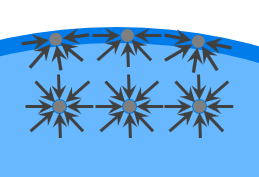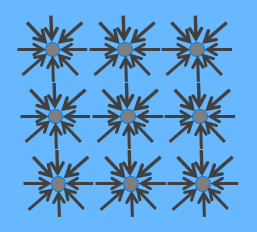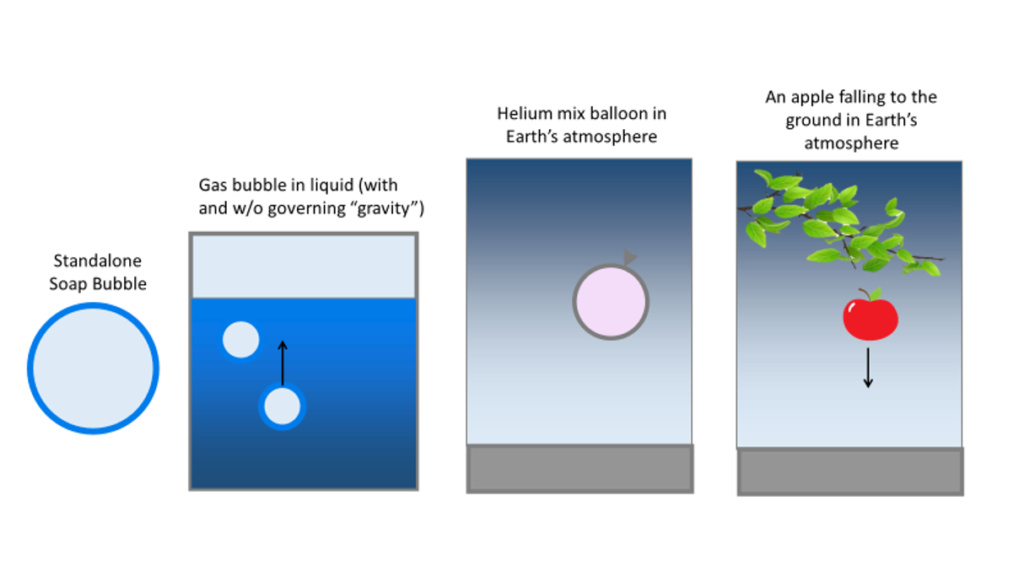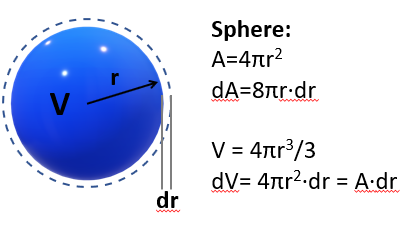Toward a better theory of “gravity” - Bubbles
2 posters
IFERS - Exposing the 'Global' Conspiracy From Atlantis to Zion :: Heliocentricity, Geocentricity, Cosmology and Cosmogeny
Page 1 of 1
 Toward a better theory of “gravity” - Bubbles
Toward a better theory of “gravity” - Bubbles
As indicated in a previous study, the "gravity" hoax is founded in the arbitrary definition of "mass" as its source and thereby also "density" as not defining the closeness of the atoms but the summarized "mass" of the atoms per volume. In order to ever find a better theory for what "gravity" really is and how it operates, we have to get out of this dead-end "mass"-inertia paradigm. We do this by returning to the basics of forces in materials and makes sure, we stay away from those inventions.
Atoms/molecules in a medium/material are drawn to each other or bound by some form of binding force (dipole-binding, electron-binding, covalent binding etc.). This is the fundamental force holding all substances together. This attractive force is small to none and even negative (repelling) in a gas whereas it in a fluid is conclusively positive while being large to extremely large in solid materials.
Considering a fluid as example, inside the medium, one atom/molecule experiences a zero net force of movements from being equally pulled in all directions or pushed equally from all directions. The forces are however there, keeping the substance together.
The molecules at the surface, on the other hand, do not have neighboring molecules above the surface and will therefore be drawn towards the solution overall as well as experience a lumping effect on the surface, resulting in a raise in density on the surface. The increased binding and force adds to the internal pressure inside the substance (which comes from the stickiness of the atoms in general). It also makes the surface of the material strive to become minimal.
The minimum surface-to-volume ratio is obtained when the volume forms a sphere (soap bubbles, balloons,…) and this relationship is described by the Laplace equation. As a step toward a new formulation of “gravity” outside of the Newtonian (“mass”, “density”, “gravity”) paradigm, let's derive the equation and examine the consequences.
Note that in the case of a balloon or soap bubble, the surface is made up of some other, more sticky or stretchy material than the enclosed volume substance. For instance rubber. This allows for the volume substance to even be a gas that might otherwise fly apart as the cohesive force of rubber is likely more then 100 times stronger than that of water.
Let's consider the case of a soap bubble (with air inside). The mathematics is interesting not only because it shows the fundamental steady state of this simpler bubble configuration that then we will likely see take part in other cases. The soap being a liquid shell, will also provide understanding that could be extrapolated to liquid-only scenarios. It also gives an interesting case of where a less dense material is trapped and compressed by a more dense one. Another example of this would otherwise be the rising CO2 bubble rising in a glass of beer or the rise of a hot-air or helium-mix balloon in the atmosphere. These cases are all physically similar (or exactly the same) and and they all ultimately come from the same kind of driving-forces.
If we look at the energy (E) of the situation, a molecule in contact with a neighboring molecule has a lower energy than if isolated. The reason is that a molecule (or atom) in the bulk of a solution has as many neighboring atoms/molecules and on average is fitted in with them in a static structure and so, has less/no energy difference relative these (the rest of the substance). A molecule set apart or significantly stretched away from the rest has an energy difference relative to the amount of that stretching. So, being at rest under larger forces, the molecules at the surface lack neighbors and are harder tied to the remaining ones and will therefore have a higher energy relative to the internal atoms/molecules of the solution overall since any movement on the surface will then require and/or release more energy. Consequently, for the solution to totally minimize its energy, the number of surface molecules (i.e. the surface area) needs to be minimized.
The SI-units of surface tension are N/m or J/m2, representing two possible understandings of surface tension:
1. As the force, F, required to stretch out a film of a substance a tiny distance, dx, i.e. (force/length) in N/m.
2. The free energy (or surface energy), dE, required to enlarge a surface area, dA, of a substance i.e. energy/area (J/m2).
Looking at item (2.), at equilibrium, this change in free energy is equal to the increase in surface energy, E, such that
where the energy-stretching coefficient, γ = dE/dA, the proportionality constant that express how much energy is stored per unit surface area, and is needed or released when changing the area one unit.
A conceptual experiment : A soap film residing on a wire frame is stretched one-dimensionally a tiny length dx by a force F. By this action, the free energy, dE, generated/added to the soap film is
In this case the differential dA of the area A is
where the “2” comes from that fact that the film in this case has two surfaces, one facing towards the reader and one facing away from the reader. Double surfaces is indeed the case when we look at soap-bubbles but in general this need not be so. One such different case is for solid bubbles of fluids (like water) in zero “gravity”. Another is fluid-filled balloons, where rubber instead pose as the surface material holding the water together. The internal stickiness of water is very low relative to that of the rubber, but it is there of course also in that case.
Note also that within the fluid film of our soap bubble, we are assuming that the inner volume fluid requires molecules/atoms are very easy-flowing compared to the atoms in the two surfaces, so that the force, F, required is (approximately) only attributable to the stretching of the surface(s). Moving on, by putting together Eqs.1,2 & 3, we get
From this, we see that for this case
It is interesting to reflect on the meaning and source of γ as it is clearly determined by the stress-energy and stress-force relationship of the substance in the film. It is not a force dependent on the “mass” nor the volume of the substance. As we can see in our initial model pictures of the bonding forces between the molecules/atoms of the substance, it is clear that γ is a combined macro-level kind-of spring-constant of the surfaces but it is not a force-spring but an energy-spring, valid only as a first linear approximation related to very small stretching of the film, dx. It is also a first concept to expand into a 2-dimensional stretching of the surfaces of a soap-film making up a soap-bubble at/near equilibrium.
If we turn from the force-perspective to the thermodynamic or energy-perspective and consider the situation for a bubble that undergoes a tiny change in size i.e. a tiny change in radius, dr, we note the basic area, volume and derivatives of those for a sphere are:
The energy equation of this tiny change will look something like this:
Here, the reduction of energy in the soap film covering the bubble is due to change of area, dA and this is opposed by mechanical work, ΔW, inside the bubble and relative to the surroundings. As we can see in the picture above, dA= -8πr·dr is already clear as we are considering a shrinking sphere (dr is negative). We also know how to obtain, γ for the substance by the previous experiment. And of course, since it is a stress-force relationship that is physically defined material property, we can likely find it out from tables of physical data. ΔW is a bit trickier but considering that this work will mainly (only) come from an increased pressure, ΔP, inside the bubble, it can be expressed as
Here, we assume that higher-order terms of dr (like dr2 and dr3) are negligible. Note that because the surface is bent, such higher-order terms will appear. Putting dA, (Eq. 5) and (Eq. 6) together, we now get the expression for dE for the energy as:
which at equilibrium (dE=0 & dE/dr=0) gives
And this gives us the Laplace equation for a soap bubble
This equation means that the pressure inside a soap-bubble (or a material) is greater than the ambient (outside) pressure and that the pressure difference is a function of to the radius and the surface tension of the soap film. It also means that for a fixed radius, the pressure inside the bubble cannot be allowed to grow larger than the ambient pressure by a factor more than 2γ/r because this is the limit of the tension that the soap surface can hold. Any larger pressure difference and the bubble bursts. This especially becomes a factor when the surrounding pressure drops. One example of this is the bursting of helium balloons at high enough altitudes. Alike there will not be enough soap to cover and hold an ever expanding soap-bubble, the fabric surrounding the helium balloons is ripped apart. Note also that a smaller bubble will have a larger pressure difference i.e. measured in the same ambient pressure, the pressure inside a small bubble is greater than in a larger bubble.
Notice also how all forces here are material forces. No "gravity".

This means that NASA's pictures showing how an air bubble "stuck" in a zero-gravity water-bubble on some "space-station", is very likely a fake. Possibly using a transparent gel to mimic the water-bubble. NASA claims that the air-bubble is stuck inside the water because there is no “gravity” forcing it out, which ofc is a lie contradicting the fact that you cannot have abubble without it having an internal pressure larger than the ambient pressure. The Ether, the surface tension and the inner stickiness of water together sets up that internal pressure gradient so that is the highest in the middle of the bubble. This pressure gradient will drive that air bubble out, also while in fake zero "gravity". So either that air-bubble manages to stay EXACTLY in the center (which is essentially impossible), or we are looking at a hoax.

NASA probably decided to “prove” that “gravity” is what sets up the pressure gradients in materials, like the pressure of the water of the oceans. All fake of course but they will say and do anything to keep the masses fooled by the idea of space. In their “experiment” they likely used a transparent gel to mimic the water-bubble or some photo trickery. I have also seen a sequence where they clearly have put water and air into a transparent plastic container, claiming air and water behave the same in zero "gravity".
But, as this outline show, the pressure of the water on the bottom of the sea, is created by the Ether and sea water itself. In that case, surface tension is likely not a factor, compared to the forces from the Ether since the amounts of water/matter is HUGE. And the inner stickiness of water likley do not compare either in magnitude to the force from the Ether. But this should be verified.
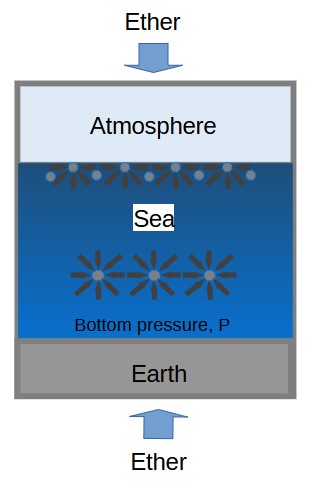
In conclusion, this exposé supports the Ether-theory of "gravity" being fully attributable to material buoyancy. In other words, as proven by the debunking of the Newtonian paradigm, "gravity" is NOT a force from a black magic volume*density ("mass") but due to material forces over the enclosing area. Particularly the force from the Ether on any material.
The hoax of turning the pressure forces into a volume force of "density" in "gravity" is also clearly seen on (for example) Wikipedias page on "Bouyancy" where we find the equation

Here, we can clearly see that "gravity" is really due to the divergence of the stress-tensor i.e. unbalanced material forces.
And this leads us back to the hoax of Newtons "law" and the need to study the ether and especially its interaction with matter. - For instance, does it have atoms? Is ether just another form of "matter"? Are atoms even real? And if all material forces are ultimately electric/magnetic, then so is also inertia.
I am curious of what the so called "gravitational constant" (G) is really made up of. I bet we will find it consists of geometry and permeability/succeptibility and permittivity i.e. the basic electromagnetic property constants of the materials.
Atoms/molecules in a medium/material are drawn to each other or bound by some form of binding force (dipole-binding, electron-binding, covalent binding etc.). This is the fundamental force holding all substances together. This attractive force is small to none and even negative (repelling) in a gas whereas it in a fluid is conclusively positive while being large to extremely large in solid materials.
Considering a fluid as example, inside the medium, one atom/molecule experiences a zero net force of movements from being equally pulled in all directions or pushed equally from all directions. The forces are however there, keeping the substance together.
The molecules at the surface, on the other hand, do not have neighboring molecules above the surface and will therefore be drawn towards the solution overall as well as experience a lumping effect on the surface, resulting in a raise in density on the surface. The increased binding and force adds to the internal pressure inside the substance (which comes from the stickiness of the atoms in general). It also makes the surface of the material strive to become minimal.
The minimum surface-to-volume ratio is obtained when the volume forms a sphere (soap bubbles, balloons,…) and this relationship is described by the Laplace equation. As a step toward a new formulation of “gravity” outside of the Newtonian (“mass”, “density”, “gravity”) paradigm, let's derive the equation and examine the consequences.
Note that in the case of a balloon or soap bubble, the surface is made up of some other, more sticky or stretchy material than the enclosed volume substance. For instance rubber. This allows for the volume substance to even be a gas that might otherwise fly apart as the cohesive force of rubber is likely more then 100 times stronger than that of water.
Let's consider the case of a soap bubble (with air inside). The mathematics is interesting not only because it shows the fundamental steady state of this simpler bubble configuration that then we will likely see take part in other cases. The soap being a liquid shell, will also provide understanding that could be extrapolated to liquid-only scenarios. It also gives an interesting case of where a less dense material is trapped and compressed by a more dense one. Another example of this would otherwise be the rising CO2 bubble rising in a glass of beer or the rise of a hot-air or helium-mix balloon in the atmosphere. These cases are all physically similar (or exactly the same) and and they all ultimately come from the same kind of driving-forces.
If we look at the energy (E) of the situation, a molecule in contact with a neighboring molecule has a lower energy than if isolated. The reason is that a molecule (or atom) in the bulk of a solution has as many neighboring atoms/molecules and on average is fitted in with them in a static structure and so, has less/no energy difference relative these (the rest of the substance). A molecule set apart or significantly stretched away from the rest has an energy difference relative to the amount of that stretching. So, being at rest under larger forces, the molecules at the surface lack neighbors and are harder tied to the remaining ones and will therefore have a higher energy relative to the internal atoms/molecules of the solution overall since any movement on the surface will then require and/or release more energy. Consequently, for the solution to totally minimize its energy, the number of surface molecules (i.e. the surface area) needs to be minimized.
The SI-units of surface tension are N/m or J/m2, representing two possible understandings of surface tension:
1. As the force, F, required to stretch out a film of a substance a tiny distance, dx, i.e. (force/length) in N/m.
2. The free energy (or surface energy), dE, required to enlarge a surface area, dA, of a substance i.e. energy/area (J/m2).
Looking at item (2.), at equilibrium, this change in free energy is equal to the increase in surface energy, E, such that
dE = γ · dA | (Eq.1) |
A conceptual experiment : A soap film residing on a wire frame is stretched one-dimensionally a tiny length dx by a force F. By this action, the free energy, dE, generated/added to the soap film is
dE = F · dx | (Eq.2) |
In this case the differential dA of the area A is
dA = 2 · L · dx | (Eq.3) |
Note also that within the fluid film of our soap bubble, we are assuming that the inner volume fluid requires molecules/atoms are very easy-flowing compared to the atoms in the two surfaces, so that the force, F, required is (approximately) only attributable to the stretching of the surface(s). Moving on, by putting together Eqs.1,2 & 3, we get
F·dx = dE = γ dA = γ 2 L · dx |
F = 2γL | |
γ = F/(2L) | (Eq.4) |
If we turn from the force-perspective to the thermodynamic or energy-perspective and consider the situation for a bubble that undergoes a tiny change in size i.e. a tiny change in radius, dr, we note the basic area, volume and derivatives of those for a sphere are:
The energy equation of this tiny change will look something like this:
dE = dA γ + ΔW | (Eq.5) |
ΔW = - ΔP·dV = - ΔP·A·dr = - ΔP·4πr2dr | (Eq.6) |
dE = γ (-8πr·dr) + ΔP·4πr2dr |
0 = | γ (-8πr·dr) + ΔP·4πr2dr |
γ8πr = | ΔP·4πr2 |
ΔP = 2γ/r | (Eq.7) |
Notice also how all forces here are material forces. No "gravity".
So, what does it mean?
The math show how the inherent material stickiness and especially surface tension plays a role in how internal pressure is set up inside ALL materials with positive stickiness γ (gas, liquid as well as solid). If we were to stack such soap-bubbles tightly, we would get a pure liquid bubble, pushed together by the ether and held together by the inner stickiness for the liquid and the surface tension. These in combination, set up the inner pressure of the liquid bubble which then is the highest in the center. No need for any "gravity" to make that happen. Just liquid vs. Ether and voilà - a bubble! Surface tension alone will never hold any large body of liquid together.
This means that NASA's pictures showing how an air bubble "stuck" in a zero-gravity water-bubble on some "space-station", is very likely a fake. Possibly using a transparent gel to mimic the water-bubble. NASA claims that the air-bubble is stuck inside the water because there is no “gravity” forcing it out, which ofc is a lie contradicting the fact that you cannot have abubble without it having an internal pressure larger than the ambient pressure. The Ether, the surface tension and the inner stickiness of water together sets up that internal pressure gradient so that is the highest in the middle of the bubble. This pressure gradient will drive that air bubble out, also while in fake zero "gravity". So either that air-bubble manages to stay EXACTLY in the center (which is essentially impossible), or we are looking at a hoax.

NASA probably decided to “prove” that “gravity” is what sets up the pressure gradients in materials, like the pressure of the water of the oceans. All fake of course but they will say and do anything to keep the masses fooled by the idea of space. In their “experiment” they likely used a transparent gel to mimic the water-bubble or some photo trickery. I have also seen a sequence where they clearly have put water and air into a transparent plastic container, claiming air and water behave the same in zero "gravity".
But, as this outline show, the pressure of the water on the bottom of the sea, is created by the Ether and sea water itself. In that case, surface tension is likely not a factor, compared to the forces from the Ether since the amounts of water/matter is HUGE. And the inner stickiness of water likley do not compare either in magnitude to the force from the Ether. But this should be verified.

In conclusion, this exposé supports the Ether-theory of "gravity" being fully attributable to material buoyancy. In other words, as proven by the debunking of the Newtonian paradigm, "gravity" is NOT a force from a black magic volume*density ("mass") but due to material forces over the enclosing area. Particularly the force from the Ether on any material.
The hoax of turning the pressure forces into a volume force of "density" in "gravity" is also clearly seen on (for example) Wikipedias page on "Bouyancy" where we find the equation

Here, we can clearly see that "gravity" is really due to the divergence of the stress-tensor i.e. unbalanced material forces.
And this leads us back to the hoax of Newtons "law" and the need to study the ether and especially its interaction with matter. - For instance, does it have atoms? Is ether just another form of "matter"? Are atoms even real? And if all material forces are ultimately electric/magnetic, then so is also inertia.
I am curious of what the so called "gravitational constant" (G) is really made up of. I bet we will find it consists of geometry and permeability/succeptibility and permittivity i.e. the basic electromagnetic property constants of the materials.
Last edited by PacMan on Sun Feb 04, 2024 11:30 pm; edited 18 times in total
PacMan- Posts : 19
Points : 1163
Reputation : 1
Join date : 2021-07-20
johnwillert, fosborn_ and tycho_brahe like this post
 Re: Toward a better theory of “gravity” - Bubbles
Re: Toward a better theory of “gravity” - Bubbles
Thank you for your work fleshing this out. I'll have to study your argument to completely understand the math (math is not my subject). Some grammar corrections could be made in the transcript, would you mind if I made the corrections and sent it back to you for your approval (Please don't take this as a criticism, I'm just trying to help.)? I would like to send this to my heliocentric brother-in-law for him to consider (Math is his subject.). My email is JohnWillert@Hotmail.com if you're interested.

johnwillert- Posts : 4
Points : 1997
Reputation : 0
Join date : 2019-02-11
Age : 64
Location : Arlington, WA
 Similar topics
Similar topics» Mathematically debunking "gravity" - A critique of Newton’s “laws”
» ISS Hoax - The International Space Station Does Not Exist!
» Aristotle, Plato and their Commentators
» Gravity Does Not Exist!
» Greenland Theory
» ISS Hoax - The International Space Station Does Not Exist!
» Aristotle, Plato and their Commentators
» Gravity Does Not Exist!
» Greenland Theory
IFERS - Exposing the 'Global' Conspiracy From Atlantis to Zion :: Heliocentricity, Geocentricity, Cosmology and Cosmogeny
Page 1 of 1
Permissions in this forum:
You cannot reply to topics in this forum|
|
|

